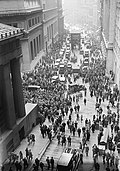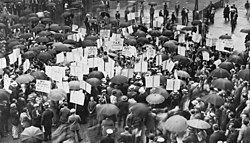Great Depression

The Great Depression was the global economic crisis that started after the U.S. stock market crash in 1929.[2] The prices on the Wall Street stock market greatly fell from October 24 to 29, 1929. Many people lost their jobs. By 1932, 25–30% of people had lost their jobs.[3] They became homeless and poor, which ended the wealth of the Roaring Twenties. Many people think that the Great Depression started on Tuesday, October 29, but economists think Black Tuesday was just one of the causes.
From 1929 to 1932, the depression worsened. Many suspect that one reason was the increased taxes on Americans such as tariffs (taxes on imports). The economist Milton Friedman said that the Great Depression was worsened because the Federal Reserve printed out less money than usual.
When the depression started, Herbert Hoover was the president of the United States and so he was blamed for it. A new president was elected in 1932, Franklin D. Roosevelt. He convinced Congress to pass many new laws and programs to help people who were hurt by the Great Depression, which were called the New Deal.
One of the programs was the Civilian Conservation Corps. The CCC put many young men to work outdoors. The men were paid thirty dollars a month for their work, twenty-five dollars of which was sent home to support their families, and they got free food and shelter.
Another program, called Social Security, continues to this day. It gives retired seniors a small income to let them have money for things that they need. The depression was a difficult time, but with everyone's help, it would get better. Between 1939 and 1944, more people had jobs again because of World War II, and the Great Depression came to an end.
Background
The Great Depression followed a decade of rapid economic growth and urbanization. After the Wall Street Crash of 1929, business declined as it had after previous stock market crashes. However, people still had hope. John D. Rockefeller said, "These are days when many are discouraged. In the 93 years of my life, depressions have come and gone. Prosperity (wealth) has always returned (come back) and will again."[4]
However, the bad effects of the depression soon grew worse and worse. More people lost jobs, money, and homes. There were reports that in Germany and the United States, there were great hunger, disease, and even starvation. Nations used protectionism more than in recent decades. That reduced international trade.
Dust Bowl
Farmers were usually safe from the severe effects of previous depressions because they could at least feed themselves. During the Great Depression, the Great Plains were also hit hard with a drought and dust storms. The events were called the Dust Bowl.
Years of overgrazing, combined with drought, caused the grass to disappear. With the topsoil exposed, high winds picked up the loose dirt and carried it over long distances. The dust storms destroyed crops and left farmers without food or crops to sell.
Small farmers were hit especially hard. Even before the dust storms had hit, the invention of the tractor drastically cut the need for manpower on farms. Small farmers were usually already in debt since they borrowed money for seed and paid it back when their crops came in. When the dust storms damaged the crops, small farmers could not feed themselves or their families and also could not pay back their debts. Banks would then foreclose on the mortgage, and the farmers' families would be homeless, unemployed, and poor.
Related pages
References
- ↑ "Dorothea Lange's "Migrant Mother" Photographs in the Farm Security Administration Collection: An Overview - Guides, Reference Aids, and Finding Aids (Prints andPhotographs ReadingRoom, Library of Congress)". loc.gov. Retrieved 13 May 2010.
- ↑ "Great Depression—FactMonster.com". factmonster.com. Retrieved 13 May 2010.
- ↑ "Great Depression (economy) -- Britannica Online Encyclopedia". britannica.com. Retrieved 13 May 2010.
- ↑
Great Depression Media
A Lone Driller's Water Break drinking from a battered pan during the Texas Oil Boom in Kilgore, Texas, 1939 — a snapshot of boomtown grit and improvisation.
Crowd gathering at the intersection of Wall Street and Broad Street after the 1929 crash
Willis C. Hawley (left) and Reed Smoot in April 1929, shortly before the Smoot–Hawley Tariff Act passed the House of Representatives
Crowds outside the Bank of United States in New York after its failure in 1931
A female factory worker in 1942, Fort Worth, Texas. Women entered the workforce as men were drafted into the armed forces.
Money supply decreased considerably between Black Tuesday and the Bank Holiday in March 1933, when there were massive bank runs across the United States.
Schultz, Stanley K. (1999). "Crashing Hopes: The Great Depression". American History 102: Civil War to the Present. University of Wisconsin–Madison. Archived from the original on 2008-03-23. Retrieved 2008-03-13..









